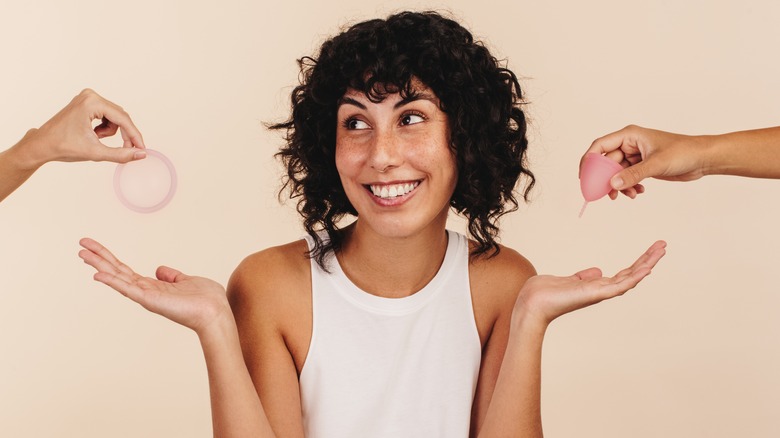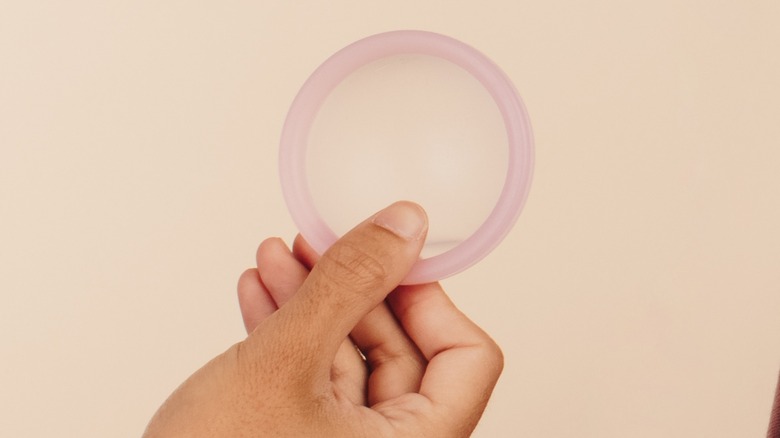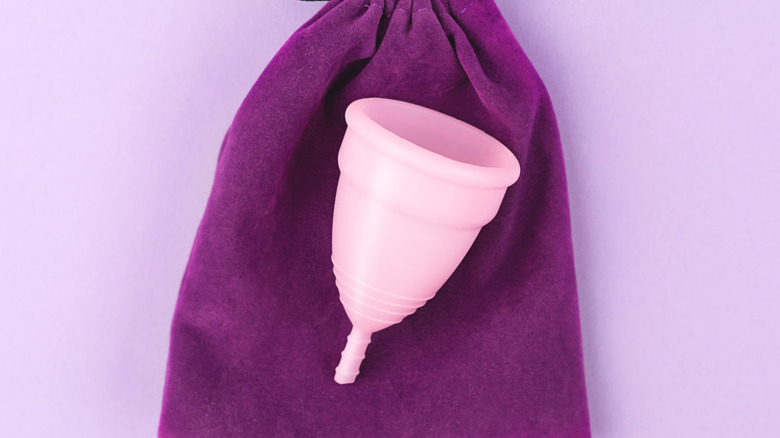Menstrual Disc Vs. Menstrual Cup: What's The Difference Between The Period Products?
Throughout time, people who menstruate have gone to great lengths to keep control of their monthly allotment of blood from ruining everything from a sexy pair of undies to those white pants that you knew would somehow summon the menstrual gods to send you your period the very day you wear them. Whether someone has a minimal blood flow or a heavy one, each case is equally an inconvenience and sometimes makes one long for the days of menopause. No more periods? Ever? Yes, please!
However, as much as having our "monthly bill," as some call it, might be a pain, we should at least be grateful that when it comes to menstrual hygiene, we have more than one option. Keep in mind: Tampons have only been on the market for about a century and the first pad wasn't available to buy until 1896.
But these days, we do have choices — and not just tampons, pads, and period underwear. As what's environmentally sound comes more and more into focus, other feminine hygiene products have hit the market — ones that don't need to be thrown away or are attached to plastic applicators that contribute to the 18 billion pounds of plastic that finds its way into the oceans every year, per National Geographic.
If you're looking for a more environmentally friendly (and cheaper, because they're not taxed like tampons and pads) option for that time of the month, then menstrual discs and menstrual cups are something to consider (via USA Facts).
Menstrual disc
Unlike tampons and pads that get tossed or flushed, menstrual discs are reusable and, for those who enjoy intercourse during their period, can be worn during penetration. When you start your period, you place the disc at the base of the cervix in the vaginal fornix. RxList defines this part of the vagina as "the anterior and posterior recesses into which the upper vagina is divided. These vault-like recesses are formed by protrusion of the cervix into the vagina." Basically, as the word "recesses" suggests, you're really going deep in there to put it in place.
"Insertion and removal may also be a bit more difficult, since the disc is placed higher in the vagina [than a menstrual cup] and it's ring-shaped," board-certified ob-gyn Renee Wellenstein tells PopSugar.
Once in place, these body-friendly discs made of medical-grade polymer (or silicone) can be worn for as many as 12 hours, depending on your menstrual flow, per Healthline. A reusable menstrual disc will set you back somewhere between $30 and $50 (via Period Shop).
Menstrual cup
For those who might struggle to find their vaginal fornix for disc placement — and it does require a bit of feeling around — there are menstrual cups. But similar to discs, cups also require a trial-and-error process as to both insertion (it collects menstrual blood by sitting in the vaginal canal) and size (not all vaginal canals are the exact same diameter).
"Knowing what cup is going to work for you definitely cuts down on some of the mishaps that could potentially happen," menstrual product expert and founder of Period Nirvana Kim Rosas tells Mashable. "But certainly even with an amazing cup, the perfect cup for you, it still takes some time."
Unlike discs, cups can't be worn during intercourse and because they are placed lower down in the vagina, they're prone to shifting. They're also not a great option for those who have an IUD. "The suction from removing the cup can cause your IUD to move out of place, making it less effective at preventing pregnancy," women's health nurse practitioner and the director of Medical Standards at Planned Parenthood Federation of America June Gupta tells Mashable.
Like discs, cups can be worn for up to 12 hours depending on your flow. After 12 hours, you can empty, rinse it, and put it back in. Most menstrual cups are made from medical-grade silicone, although sometimes rubber and latex is used. This is something to be wary of if you have a latex allergy. Reusable menstrual cups cost between $20 and $40, and have up to a 10-year lifetime, making them a fantastic investment (via Forbes).
As is the case between tampons and pads, when it comes to discs vs. cups, it's all about what you're comfort with using and that's only something you can figure out on your own.


